Today’s Hours: 7:00am - 1:30pm
Today’s Hours: 7:00am - 1:30pm
Explore Habitats and Encounter Our Majestic Animals.
Species Name:Adansonia digitata
Living up to 2,000 years old, this iconic tree is considered one of the largest succulent plant species in the world. It rarely reaches 75 feet tall, but its trunk can…
Read MoreFamily
Conservation Status
Range
Habitat
Highlights
Living up to 2,000 years old, this iconic tree is considered one of the largest succulent plant species in the world. It rarely reaches 75 feet tall, but its trunk can reach up to 80 feet in circumference where it specializes in water storage. Sometime considered grotesque, when its leaves have dropped the tree’s branches resemble a giant root system, giving the appearance that the tree is growing upside-down. Baobab trees are an important resource for people and animals. Hollow trunked trees have provided people with shelter for centuries. The spongy wood, leaves, flowers, and fruit provide food for many animal species including elephants and baboons.
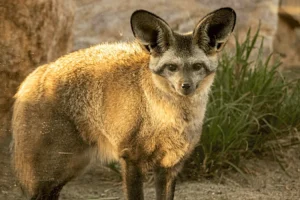
Species Name:Otocyon megalotis
Their coats are yellowish-brown with brown feet and ear tips and blackish brown faces. Their legs are relatively short, and tails bushy, darkening in color towards the tip and their ears…
Read MoreCanidae, the dog family.
Not threatened.
East and South Africa.
Savannas and open plains with tall grass, thick brush and burrows for hiding. Found in close proximity to ungulates
The bat-eared fox is possibly named after the Egyptian slit-faced fruit bat, which also has ears that are large in proportion to its head.
Their coats are yellowish-brown with brown feet and ear tips and blackish brown faces. Their legs are relatively short, and tails bushy, darkening in color towards the tip and their ears are approximately 5 inches long.
They are the only canids that prefer insects to mammalian prey. Eighty percent of their diet consists of insects, particularly harvester termites and dung beetles, as well as fruits, scorpions and an occasional small mammal or bird. They are hunted by native peoples for their pelts and meat and also by carnivores such as the black-backed jackal, slender mongoose and brown hyena.
Bat-eared foxes usually breed in pairs, giving birth in self-dug dens. But single males may breed with two females and two or three breeding dens may be clustered within a few hundred meters, where soil and vegetation are suitable. After a 60-70 day gestation period, two to five pups are born. Juveniles achieve adult size at 4 months, when they begin to accompany adults on foraging trips. Groups can include up to 12 foxes.
Species Name:Yucca rostrata
A handsome and arborescent yucca with a neat vertical silver profile that lends itself very well to crisp, modern xeriscape gardens.
Read MoreA handsome and arborescent yucca with a neat vertical silver profile that lends itself very well to crisp, modern xeriscape gardens.
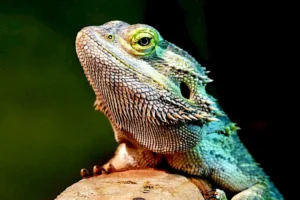
Species Name:Pogona vitticeps
This mid-sized stocky arboreal lizard has prominent spines along its sides, a large triangular head and a spiny jaw pouch that looks like a beard when swollen. The color on its…
Read MoreAgamidae, the agama lizard family.
None.
Central Australia.
Desert to semi-arid woodland.
The name “dragon” comes from the color of the interior of the mouth. When opened, it gives the appearance of breathing fire. This action is used to deter predators or male rivals during the breeding season.
This mid-sized stocky arboreal lizard has prominent spines along its sides, a large triangular head and a spiny jaw pouch that looks like a beard when swollen. The color on its upper parts varies from shades of brown, gray, reddish-brown to bright orange while the ventral surface ranges from pale to dark gray with white elongated spots edged with black.
Mature males have dark beards that become black during courtship and breeding. Adults can grow up to 2 ft. in length, the tail accounting for more than half of this and males are larger than females. They are omnivores, consuming many types of insects, small vertebrates and vegetation including fruits and flowers. They are preyed on by dingos and monitor lizards. They reach sexual maturity at one to two years of age and females lay clutches of from 11-30 leathery oblong-shaped eggs in early summer in nests dug in sandy soil. The young hatch unattended three months later. Forming a shield-like structure around the snout is a spiny jaw pouch which, when inflated, looks like a beard and is used in courtship displays as well as to deter predators from attacking.
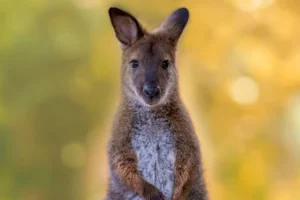
Species Name:Macropus rufogriseus
Bennett’s wallaby is a member of the macropod family. Macropod means “large foot” and refers to a family of marsupials including kangaroos and pademelons native to Australia. Well-developed males tend to…
Read MoreLeast Concern.
This medium-sized wallaby is found in eastern Australia, from Queensland to South Australia. It can also be found in Tasmania.
Bennett’s wallaby inhabits eucalypt forests, coastal shrublands, and grazing fields.
Bennett’s wallaby is a member of the macropod family. Macropod means “large foot” and refers to a family of marsupials including kangaroos and pademelons native to Australia.
Well-developed males tend to be aggressive with each other and they fight by ‘boxing’. When these wallabies feel threatened, they stamp their feet to alert others. They can also communicate using their ears, scent marking, and some vocalizations like growling and hissing.
Bennett’s wallaby has grey to reddish fur coloration, white cheek markings, and a patch of reddish fur on the neck. It has a white or light grey abdomen and a dark brown muzzle. Its head-body length reaches up to 40 inches, males being generally larger than females. Its ears are longer in proportion to other wallaby and kangaroo species and can turn to the side, which contributes to its keen hearing.
Species Name:Bismarckia nobilis
The large, silver-blue leaves of this majestic Madagascan palm provide eye-catching contrast in gardens regularly dominated by various shades of green.
Read MoreThe large, silver-blue leaves of this majestic Madagascan palm provide eye-catching contrast in gardens regularly dominated by various shades of green.
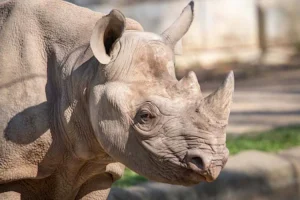
Species Name:Diceros bicornis michaeli
Black rhino are browsers and have a prehensile upper lip that allows them to easily eat trees and shrubs. They are more solitary than other rhino species; however, females can be…
Read MoreRhinocerotidae
Critically Endangered
Sub-Saharan and Eastern Africa, primarily Kenya and Tanzania, with an introduced population in South Africa
Tropical bushlands and savannas
Black rhinos are not black at all, but rather dark gray. They are constantly coated in a mud coat to help keep them cool and prevent insect bites.
Black rhino are browsers and have a prehensile upper lip that allows them to easily eat trees and shrubs. They are more solitary than other rhino species; however, females can be found at watering holes, while males stay alone.
Together, a group if rhinos is called a ‘crash’. Although rhinos have poor eyesight, they communicate with each other through vocalizations, sneezes, and by scent. Black rhinos are not black at all, but rather dark gray. They are constantly coated in a mud coat to help keep them cool and prevent insect bites.
Rhinos mothers are very attentive and protective of their calves. Rhino calves stay with their mothers for up to four years. Black rhino have two horns that are made of keratin – the same material as human fingernails, animal hooves, bird feathers and beaks, and reptile and fish scales. Threat: Poaching for their horns, illegal wildlife trade.
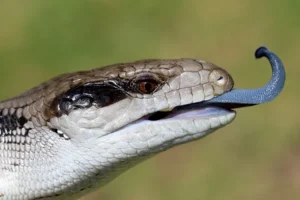
Species Name:Tiliqua scincoides
The blue-tongue skink spends most of the day searching for food. Although it is slow-moving, its brown-banded body helps it camouflage into the surrounding landscape. When threatened, blue-tongue skinks open their…
Read MoreScincidae
Least Concern
Northern Australia
Grasslands, shrublands, savannas, forests
Blue-tongued skinks are threatened by habitat loss, increasing wildfires due to climate change, agricultural toxins, and predation by foxes, dogs, and feral cats.
The blue-tongue skink spends most of the day searching for food. Although it is slow-moving, its brown-banded body helps it camouflage into the surrounding landscape.
When threatened, blue-tongue skinks open their mouth wide and deploy their ultraviolet blue-tongued, sharply contrasting their pink mouth. They also flatten their body to appear larger, thereby frightening potential predators.
Blue-tongued skinks get around using a serpentine (snake-like) movement, slithering on their bellies and using their feet to push themselves along.